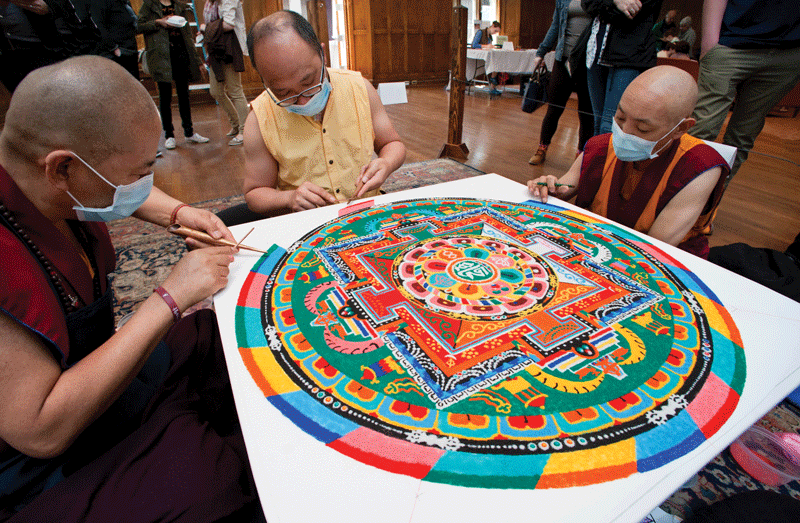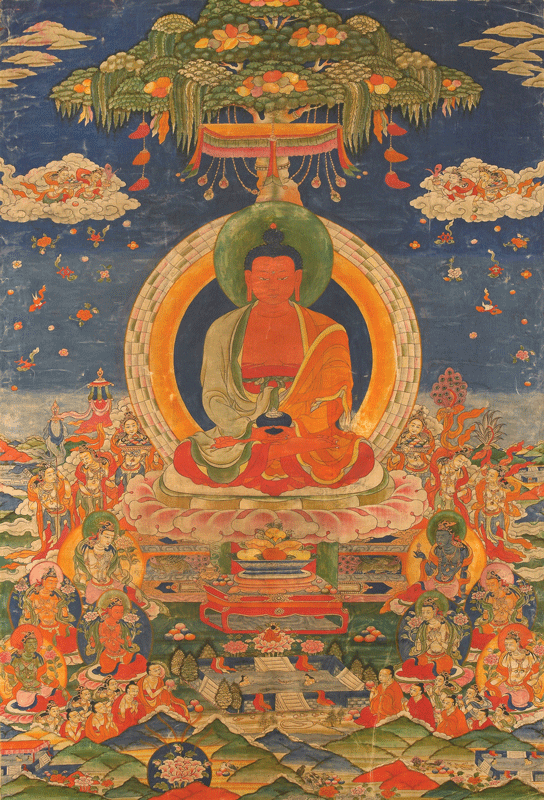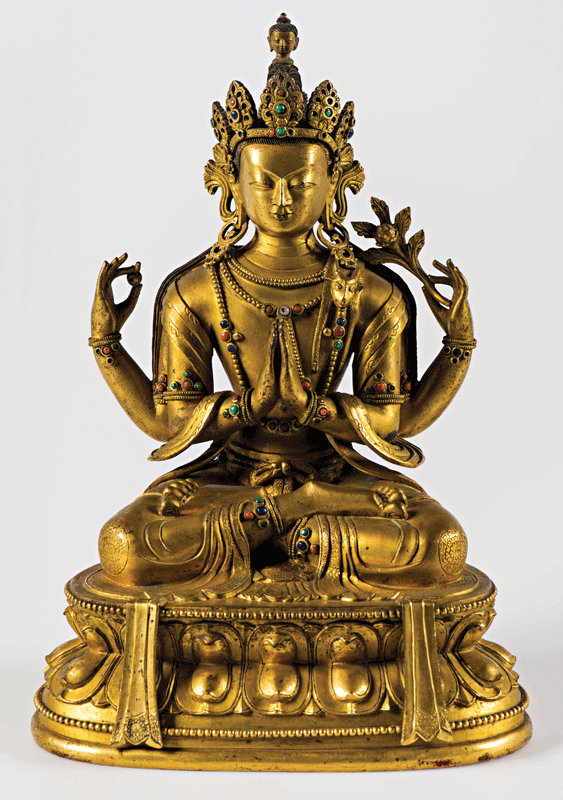Embodying Compassion Exhibition and Mandala

Buddhism has millions of practi-tioners worldwide. Throughout the regions where it is practiced most, countless shrines, temples, and pilgrimage sites stand in honor of the figure known as Avalokiteshvara, who is the embodiment of compassion. Yet there has never been a wide-ranging, pan-Asian examination of his iconography and significance in an American museum until this spring.
Buddhist art and culture became a part of Vassar’s campus in an unprecedented way in late April. Vassar’s Frances Lehman Loeb Art Center hosted a first-of-its-kind art exhibition of Buddhist art, curated by art history professor Karen Lucic. Embodying Compassion in Buddhist Art: Image, Pilgrimage, Practice featured works from several nations including India, China, Nepal, Japan, and Tibet. Works came on loan from the American Museum of Natural History, the Metropolitan Museum of Art, Jacques Marchais Museum of Tibetan Art, Princeton University Art Museum, the Rubin Museum of Art, Asia Society in New York, and others.
“These images are from the leading collections of this kind of material in New York,” says Lucic, who also authored the exhibition catalogue. She says the process of researching and borrowing exhibition pieces took years. “I’m still amazed that we got so many works. Some are extremely rare, and some are the most outstanding works in their institution’s collection,” she reports.
In conjunction with the exhibition, three Buddhist lamas created an intricate and colorful mandala in a six-day public display in the College Center.

Dr. Hun Yeow Lye—founder and spiritual director of the Urban Dharma North Carolina in Asheville and one of the three lamas who created the mandala—led a discussion about the history and meaning of mandalas (Sanskrit for “circles”). They can be buildings, paintings, and other permanent and impermanent objects—all with a circular shape—that represent various deities, he says. One famous mandala, Lye notes, depicted 722 deities.
The mandala created at Vassar represented Avalokiteshvara, or Chenrezig, the embodiment of compassion in Tibetan Buddhism. As the mandala was being created, it was channeling the blessings of compassion to those present, Lye says.
Likewise, each of the objects in the Art Center exhibition—from sculptures to paintings—reflect Avalokiteshvara and the message of compassion.
“Buddhism relies on art to a significant extent,” Lucic says, noting the connection between the religion and the mandalas, icons, and other objects for which it is well known.
Lye and fellow monks Ven. Khenpo Choephel, originally from Drigung-til Monastery in Tibet, and Lama Konchok Sonam Karushar, originally from Katsel Monastery in Tibet, engaged with spectators during breaks in the painstaking process of creating the colorful design out of powdered minerals (which some mistake for sand).
Hundreds of students, faculty members, administrators, employees, and visitors came to witness the creation of the mandala, which began with a meticulous kaleidoscopic drawing created by the monks on their first day. It’s a process that can easily enrapture those who witness it, Lucic says.
“I had gone to the Asia Society galleries last year to see an important exhibition of Tibetan art and stepped into the space where these lamas were constructing a mandala. I only intended to spend a few minutes watching the process. Two hours later, I was still there,” she says.

The Rev. Samuel Speers, director of the Office of Religious and Spiritual Life, which organized and sponsored the mandala demonstration, says he could tell the people who visited the mandala were spiritually moved by what they saw.
“I was thrilled with the response that it received. We wanted to make sure people, on campus and beyond it, know how much the office is committed to both terms in our office title. We are the Office of Religious and Spiritual Life,” he says.
The project was a significant learning experience for students, says Speers. The mandala and the exhibition were part of a program they had been working on for months—“The idea was for students to think about what embodying compassion looks like,” he says.
The mandala demonstration culminated on the sixth day in a dissolution ceremony. The lamas brushed the minerals into a vase that was then wrapped with a colorful scarf, and walked in a procession to Sunset Lake. Per tradition, the contents were released into the water following chanted prayers.
The dissolution ceremony (which can be viewed here) attracted a crowd of about 150 people, and the Art Center exhibition drew a remarkable number of visitors, Lucic says.
The Art Center exhibition was part of Lucic’s plan for phased retirement, begun five years ago. Through the project, she was able to reduce her teaching load and devote herself to research. As someone who had long been interested in Buddhist art, Lucic decided to create an exhibit that was unprecedented in the Art Center’s history.
“It was a huge and wonderful opportunity,” says Lucic, adding that the popular exhibition has even led to growth in Vassar’s permanent collection. “Our Asian collection is growing, in part, because of this exhibition,” she notes. “Some new purchases have been made by the [Art Center] director, but we’ve also received some extremely generous gifts. They will not only enhance the exhibition but will go into the permanent Asian galleries as something for students to learn from and for the public to enjoy.”
